
As a poker player, you will forever ask yourself if you must play the hand. Don't let confusion get the best of you. In a poker game, hands represent the combinations of cards players hold. They are the deciding factor when it comes to who wins the game.
If we have to speak strategically, there are 2,598,960 possible unique combinations of five cards, which is the number of possible poker hands using a standard card deck. And if we look at unique two-card combinations, there are about 169. That said, some poker hands are better than others.
But choosing which poker hands to play depends on more than card strength. Your position, opponents' actions, and styles all come into play.
Early positions require caution, whereas late positions offer more information. But you don't have to worry because we've got you covered with the poker starting hands cheat sheet. From walking you through the best starting hands in poker to poker notations, we have it all covered. Read on!
Best Poker Hands - Starting Hands in Texas Hold'em Poker

Starting hands in Texas Hold'em are the two initial cards or the hole cards dealt face down to each player before any community cards are revealed in the poker preflop round. These starting hands form the basis of a player's hand and greatly influence their decisions throughout the hand. In most poker games, the strength of the starting hands remains the same.
Take a look at the starting hand's poker chart. It helps you understand premium to weak hands. You can save this as your poker starting hands cheat sheet.
| Premium Hands | Strong Hands | Playable Hands | Marginal Hands | Weak Hands |
| Pocket Aces (AA) | Pocket Jacks (JJ) | King Jack Suited (KJs) | King Ten Suited (KTs) | King Nine Suited (K9s) |
| Pocket Kings (KK) | Pocket Tens (TT) | Queen Jack Suited (QJs) | Queen Nine Suited (Q9s) | Queen Eight Suited (Q8s) |
| Pocket Queens (QQ) | Ace Queen Suited (AQs) | Jack Ten Suited (JTs) | Jack Eight Suited (J8s) | Jack Seven Suited (J7s) |
| Ace King Suited (AKs) | Ace Jack Suited (AJs) | Ace Nine Suited (A9s) | Ten Eight Suited (T8s) | Ten Seven Suited (T7s) |
| Ace King Offsuit (AK) | King Queen Suited (KQs) | Ace Eight Suited (A8s) | Nine Eight Suited (98s) | Nine Six Suited (96s) |
| Pocket Nines (99) | Ace Ten Offsuit (AT) | Ace Seven Suited (A7s) | Eight Six Suited (86s) | |
| Pocket Eights (88) | King Queen Offsuit (KQ) | Ace Six Suited (A6s) | Seven Six Suited (76s) | |
| Ace Ten Suited (ATs) | Queen Ten Suited (QTs) | Ace Five Suited (A5s) | Five Four Suited (54s) | |
| Jack Nine Suited (J9s) | Ace Four Suited (A4s) | Four Three Suited (43s) | ||
| Ten Nine Suited (T9s) | Ace Three Suited (A3s) | Three Two Suited (32s) | ||
| Ace Two Suited (A2s) | King Nine Offsuit (K9o) | |||
| King Jack Offsuit (KJo) | Queen Eight Offsuit (Q8o) | |||
| Queen Jack Offsuit (QJo) | Jack Six Suited (J6s) | |||
| Jack Ten Offsuit (JTo) | Ten Eight Offsuit (T8o) | |||
| Ten Nine Offsuit (T9o) | Eight Five Suited (85s) | |||
| Nine Seven Suited (97s) | Six Five Suited (65s) | |||
| Eight Seven Suited (87s) | Five Three Suited (53s) | |||
| Four Two Suited (42s) | ||||
| Three Two Offsuit (32o) |
Now that you have reviewed the poker cheat sheet, understanding which starting hands are the best starting hands in poker and which ones are weak is important to playing the game well. Take a look!
Premium Hands
These poker best starting hands are the strongest and should be played aggressively in most situations. Pocket Pairs like Pocket Aces or Pocket Kings are the best starting hands.
Good Hands
While these are not the poker best starting hands, they are solid and can lead to strong hands on the flop. For example, the Ace and King of Spades combination is known as the Big Slick.
Playable Hands
These hands can be played in certain situations but require more caution. For example, the Ace and Jack combination is decent but can be dominated by stronger hands.
Marginal Hands
These hands are playable in certain scenarios in a poker game but require careful consideration. For instance, Small Pairs can be played cautiously, hoping to hit a set on the flop.
Weak Hands
These hands are generally not worth playing unless you are in the blinds and can see the flop for free.
Also, an important point to remember is that while starting hands are important, the strength of your hand and playing style can change dramatically after the flop, turn, and river. However, good hand selection is just the beginning of successful play in poker games. It's almost like a first step toward winning poker.
Starting Hand Notations in Poker

Don't be scared by the word notation. It's not something complicated but just a way of writing the ranges of poker hands so others can read it and analyze the hands on the poker table or online. This is one of the important poker skills that poker players must possess. Let's take a look!
Suited Cards and Off-Suited cards
s: This denotes suited cards hand, where both cards share the same suit (hearts, diamonds, clubs, spades). For example, K♣Q♣ (king of clubs, queen of clubs) or J♦8♦ (jack of diamonds, eight of diamonds) would be written Ks or J8s.
o: This denotes off-suited cards hand, with different suits. For example, K♦Q♣ (king of diamonds, queen of clubs) or A♥7♠ (ace of hearts, seven of spades) would be written Ko or A7o.
Card Ranks
Cards are represented by their initials. A = Ace, K = King, Q = Queen, J = Jack, T = Ten, and numbers 2 through 9. And, pocket pairs are indicated by repeating the rank of the pair, e.g., AA for a pair of Aces, 88 for a pair of Eights, for pocket kings, you use KK.
Connectors and Gappers
Hands with consecutive ranks, such as 76 or JT, are often called connectors. When there's a gap between the two cards, such as 86 or Q9, they are referred to as gappers.
Additional Notation
+: Sometimes used to indicate hands with a specific card value or higher. For example, AQo+ would mean any Ace-Queen hand where the Queen is a ten or higher (AQt, AQc, AK).
These are the notations that will come in handy in starting hands poker!
Position-Based Starting Hands
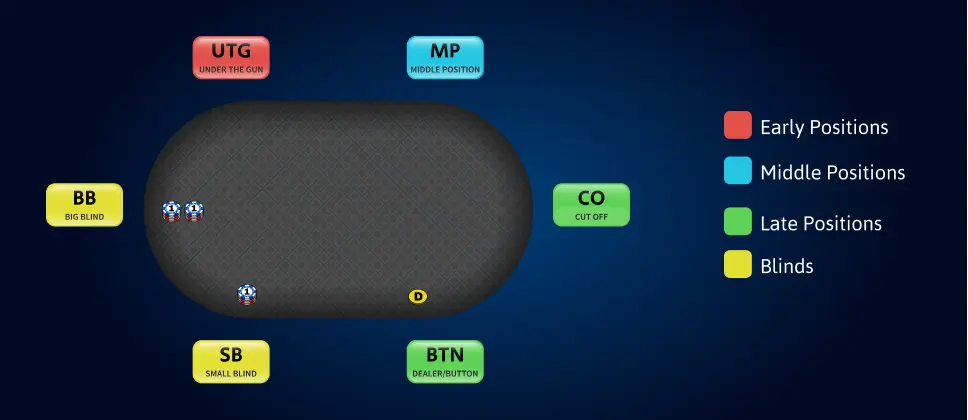
The image depicted is for a table of six.
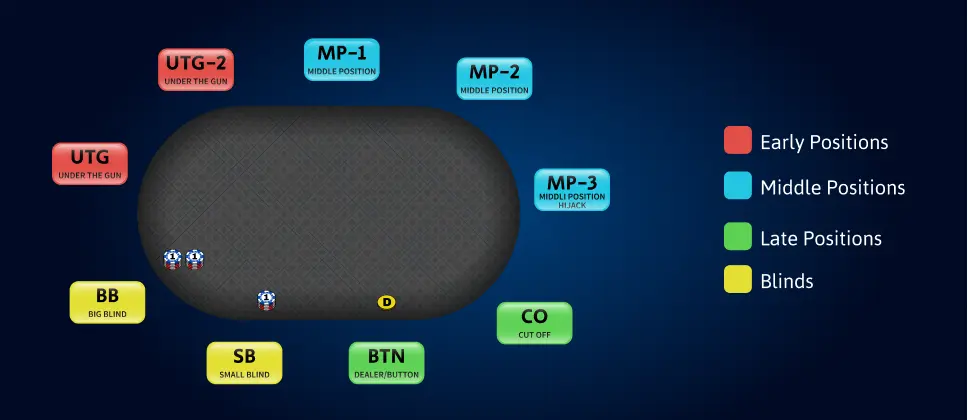
The image depicted is for a table of 9
When it comes to starting hands poker, position matters even with the best starting hands in poker. Here's how:
Early Position (EP)
This includes the first few seats to act after the blinds. Since they act first, they have the least information and face the most opponents who can potentially call or raise. Therefore, EP players must be very selective with their starting hands and focus on strong, high-card combinations.
In an early position, it's advisable to play tighter and stick to stronger hands with good potential to win without needing much help from the community cards. This is crucial when it comes to poker starting hands in EP.
Middle Position (MP)
These are the middle seats. They have slightly more information than early positions as they see a few players act beforehand. They can start to open their hand selection a bit more compared to EP, but they still need to be cautious. Hands like medium pairs (TT-88), broadway cards (e.g., AQ, KJ), and suited connectors, e.g., 76s, 54s, might be playable here.
Late Position (LP)
This includes the button, cutoff seat, and hijack (the two seats to the right of the cutoff). Late-position players have the most information and the advantage of potentially stealing the blinds. They can play a wider range of hands, including suited connectors and lower pocket pairs because they can make better decisions based on the pre-flop actions.
Blind Positions
Due to their forced bets, the small blind (SB) and big blind (BB) positions have unique considerations. The SB is often considered a disadvantageous position, so players tend to play tighter ranges. In the BB, players can play a wider range of hands compared to other positions due to already invested chips in the pot.
Button
The button is the most beneficial position as it acts last in every round of betting post-flop. Players on the button can play a wide range of hands, including weaker hands, steal attempts, and speculative hands, depending on the players' actions before them.
Which Starting Hands Should You Play From Your Position?
Make use of the starting hands poker chart below as your guide to see which poker starting hands to play from a particular position.
Playing Pairs and Suited Hands Poker Starting Hands Chart:
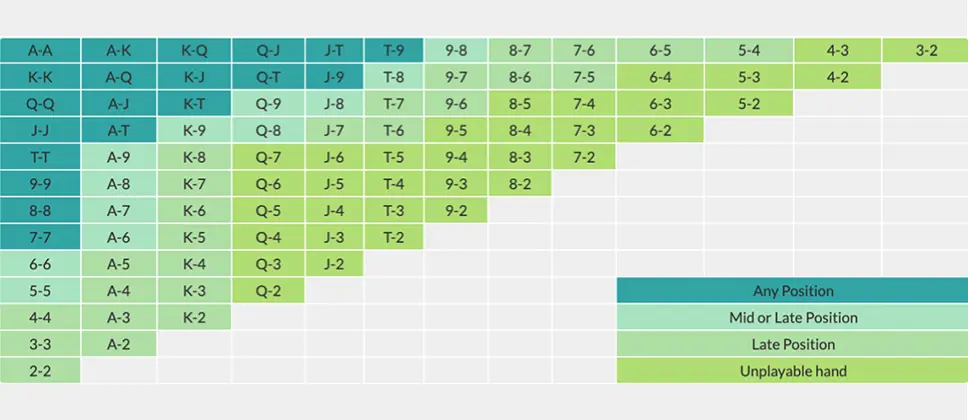
Playing Off-Suited Hands Poker Starting Hands Chart:

Here's an explanation of the best starting hands in poker as per your position:
Early Position (EP) or Under The Gun
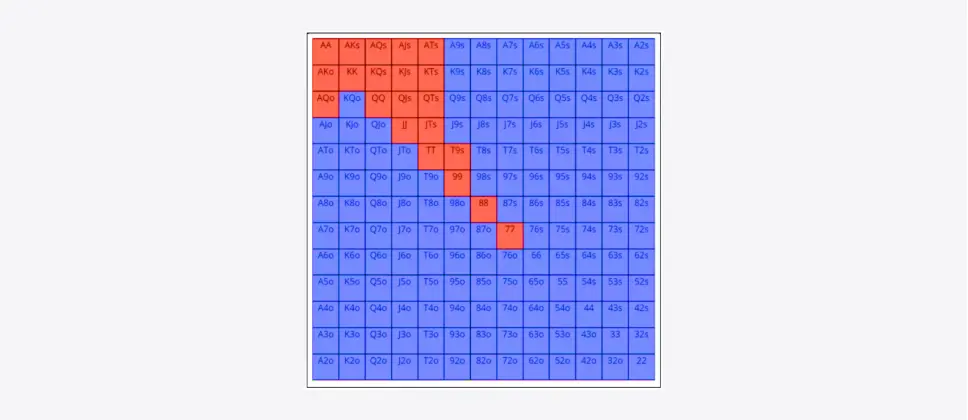
The red squares show the recommended hands from the UTG position. These include pocket pairs 77+, suited connectors T9s+, premium Broadway hands like AQo+, and strong-suited aces like ATs+. This tight range minimizes exposure to 3-bets and maximizes post-flop strength.
Middle Position (MP)
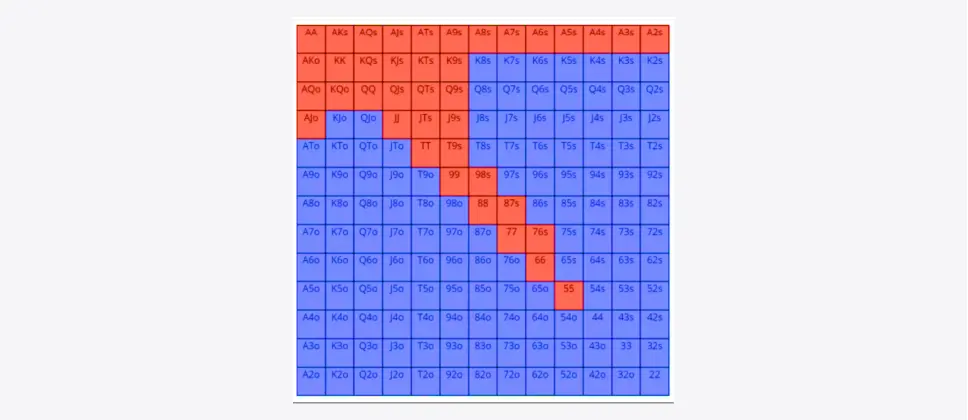
The red squares highlight the ones you should play from the LoJack position in the early mid-position. In LoJack, after some players have folded, you want to be a bit more aggressive. So, you can play stronger hands like pocket pairs (starting from 55), suited cards like A2s+, and connectors like 76s+. This range also includes some stronger hands like J9s+ and Q9s+, which give you good chances of making strong hands after the flop. Overall, in LoJack, you can play a wider range of hands compared to earlier positions.
In later middle positions, you must continue playing premium hands like high pairs (AA-99), strong aces (AK-AJ), and Broadway cards (AK, AQ). However, you can add some medium pairs (88-66), suited connectors, and suited aces to your range.
Late Position (LP)
Play premium hands and medium pairs (99-66), suited connectors, suited aces, and suited one-gappers. It's all about the suited cards here. See if you can raise with weaker hands to steal blinds and antes, especially if the players in the blinds are tight.
Blind Positions
The small blind (SB) and big blind (BB) positions require adjusting your starting hand range due to the forced bets. In the small blind, play relatively tight, focus on strong hands, and playable hands in position.
In the big blind, you will have already invested chips, so you can defend with a wider range, including suited hands like suited connectors, suited aces, and small pairs, especially against late position raises.
Button (BTN)
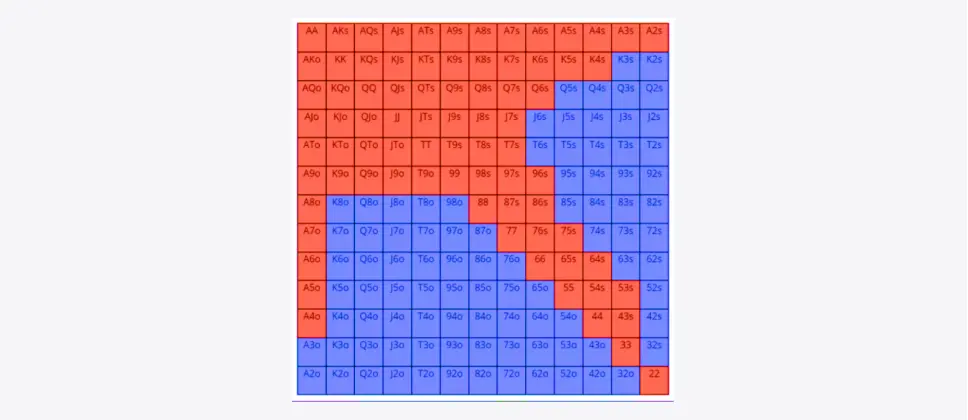
In the Button (BTN) position, you can play a wide range of hands because you're the last to act before the blinds. This range includes many suited cards, pocket pairs, and even some weaker offsuit hands. Since you only have the blinds left to act after you, you can raise with these hands, making it more likely that the blinds will fold and you can win the pot.
Types of Poker Hands
Now that you know about poker's best-starting hands, let's take a look at the best poker hands.
Royal Flush: A royal flush is an unbeatable poker hand. A royal flush consists of five consecutive cards of the same suit, from ten to ace.
Straight Flush: We call the set a straight flush when it has five consecutive cards of the same suit, but not necessarily the highest. For example, 8♦7♦6♦5♦4♦ is a straight flush. This poker hand is also one of the best after the royal flush.
Four of a Kind: Four cards of the same rank and one kicker, which means any other card, put together makes a four-of-a-kind. For example, 4♣4♥4♠4♦2♠ is a four of a kind fours with a two kicker.
Full House: A three-of-a-kind and a pair make a full house. For example, A♥A♦A♠6♦6♣ is a full house.
Flush: Five cards of the same suit but not put together in a sequence make a flush. For example, A♥K♥Q♥J♥7♥ is a flush.
Straight: Five consecutive cards of any different suit are known as straight. For example, 10♣9♦8♥7♠6♠ is a straight.
Three of a Kind: Three cards of the same rank and two kickers, which means any other cards with the three cards make a three-of-a-kind. For example, 3♦3♣3♠5♥7♠. This is part of the weaker ones in poker hands.
Two Pair: Two different pairs and a kicker make a two-pair. For example, A♥A♠K♣Q♦J♥.
One Pair: Two cards of the same rank and three kickers make one pair or a pair. For example, K♣K♦Q♥8♠5♣. When it comes to a poker hand, this is the weakest.
High Card: If players have no combinations, as mentioned above, the highest card in your hand determines the winner. For example, in A♠K♣Q♦J♥7♣, the high card ace.
Best Poker Hands - Texas Hold'em Starting Hands
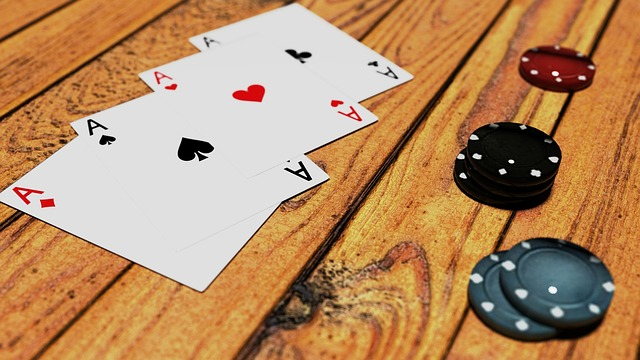
Let's take a look at the best-starting hands in Texas Hold'em. The poker starting hands ranking below starts with the highest to lowest starting hands.
Pocket Aces (AA)
This is one of the best poker starting hands as per the poker starting hands ranking. These starting hands in poker should almost always be played aggressively, where you aim to build the pot before the flop. While it is an extremely strong pre-flop, you must be cautious with every step you take to make the best of it.
Pocket Kings (KK)
Pocket Kings poker starting hands ranked as the second-best starting hand in poker. Similar to pocket aces, they should be played aggressively pre-flop.
Pocket Queens (QQ)
As poker starting hands ranking, pocket queens are the third-ranked poker starting hand. These starting hands in poker are strong but vulnerable to overcards, especially from AK. While still a premium hand, you must make every move mindfully.
Ace-King Suited (AKs)
Ace-king suited is a powerful hand on the poker starting hands chart that offers numerous post-flop possibilities. While not as strong as pocket pairs, AKs can make great hands like straights and flushes.
Pocket Jacks (JJ)
Pocket jacks are strong but can be vulnerable to overpairs and overcards. Players should play them aggressively pre-flop but maintain caution post-flop, particularly on high-card boards.
Ace-King Offsuit (AK)
Ace-king offsuit is a strong hand but lacks the potential of its suited counterpart. You should aim to build the pot pre-flop, but be careful post-flop.
Pocket Tens (TT)
Pocket tens are strong but can be vulnerable to overpairs and overcards. Players should play them aggressively pre-flop but exercise caution post-flop. You must adjust your game based on the situational dynamics and this is the key to improving the hand's potential.
Ace-Queen Suited (AQs)
Ace-queen suited offers strong post-flop playability, particularly in position. While vulnerable to higher kickers, AQs can make strong hands and draws. But make sure you balance aggression with the right decisions.
Ace-Jack Suited (AJs)
Ace-jack suited offers similar playability to AQs, with the advantage of potential straight and flush draws. Players should aim to play AJs aggressively in position.
King-Queen Suited (KQs)
King-queen suited offers strong playability and potential for draws. While not as strong as premium hands, KQs can make strong hands and draws.
Starting Hand Examples
Let's look at a few best-starting hands poker to help you understand them even better.
Example 1
Let's say you are sitting in the early position, and you are dealt Q♦ J♦.
Now, QJ is a Group C hand, and the situation is UNRAISED.
According to the UNRAISED Action chart for Early Position with a Group C hand, the recommendation is to fold as early position lacks information on opponents' hands, and QJ suited relies heavily on hitting strong community cards.
Example 2
Imagine being in the middle position and being dealt 10♠ 10♣. 10-10 is a Group B hand, and the situation is UNRAISED.
With a Group B hand in the UNRAISED situation from the Middle Position, the recommended action is to make an opening raise.
Group B hands like 10-10 have good strength and benefit from thinning the field pre-flop. Raising builds the pot and lets you control the betting action, increasing value.
Example 3
Now, the picture being dealt 7♠ 7♦ and 7-7 is a Group C hand. You are in a late position, and the situation is UNRAISED.
In a UNRAISED situation from a Late Position with a Group C hand like 7-7, the recommendation is to fold because Group C hands lack strength and can face uncertainty in a late position due to stronger hands from earlier positions.
Statistics based on real online play
Take a look at the real-world data from poker games, considering the actual outcomes associated with different starting hands.
| Tier | Hands | Expected Value |
| 1 | AA, KK, QQ, JJ, AKs | 2.32 - 0.78 |
| 2 | AQs, TT, AK, AJs, KQs, 99 | 0.59 - 0.38 |
| 3 | ATs, AQ, KJs, 88, KTs, QJs | 0.32 - 0.20 |
| 4 | A9s, AJ, QTs, KQ, 77, JTs | 0.19 - 0.15 |
| 5 | A8s, K9s, AT, A5s, A7s | 0.10 - 0.08 |
| 6 | KJ, 66, T9s, A4s, Q9s | 0.08 - 0.05 |
| 7 | J9s, QJ, A6s, 55, A3s, K8s, KT | 0.04 - 0.01 |
| 8 | 98s, T8s, K7s, A2s | 0.00 |
| 9 | 87s, QT, Q8s, 44, A9, J8s, 76s, JT | (-) 0.02 - 0.03 |
What are the starting hands on a poker table?
Starting hands in poker are the two cards dealt face-down to each player at the beginning of a hand. They are known as hole cards or pocket cards since they are known only to the player to whom they are dealt. Some of the best starting hands in poker include high pair.
What is the best-starting hand in poker?
The best starting hand in poker is two Aces, often called pocket Aces or bullets. This pair of Aces is, in fact, great as it provides a strong foundation for a winning hand. The poker starting hands percentages for pocket aces include 0.45%. After the Pocket Aces, the next best starting hands in poker are pocket Kings (KK), also known as cowboys. Like Aces, Kings are some of the best starting hands in poker, providing a strong chance of winning before the community cards are dealt.
What percentage of poker starting hands should I play in Texas Hold’em?
In Texas Hold'em, the poker starting hands percentages vary based on your strategy and position. In most cases, tight-aggressive players stick to premium hands like high pairs and strong-suited connectors, playing around 15-20% of hands. Loose-aggressive players broaden their range to about 20-30%.
What are bad starting hands in poker?
Bad starting hands in poker are those with low potential to form strong hands post-flop. Common examples include unsuited low cards 7-2. These are known as trash or rags, lacking connectivity and high card value.
Who is the first to bet in Texas Hold’em?
In Texas Hold'em, the player to the left of the dealer button is the first to bet in each round of betting, except for the pre-flop betting round, where the two players to the left of the dealer post the small blind and big blind, respectively. Fun fact? This player's position is known as 'under the gun.' The betting takes place clockwise.
How many starting hands are there in poker?
In Texas Hold'em, there are 169 unique starting hands, which include all possible combinations of two-hole cards from a standard 52-card deck. These hands vary in strength, from best starting hands in poker like Aces to weaker combinations like low unsuited cards. You must know that the relative strength of different starting hands is crucial to make the right decisions during the game and ace it.

